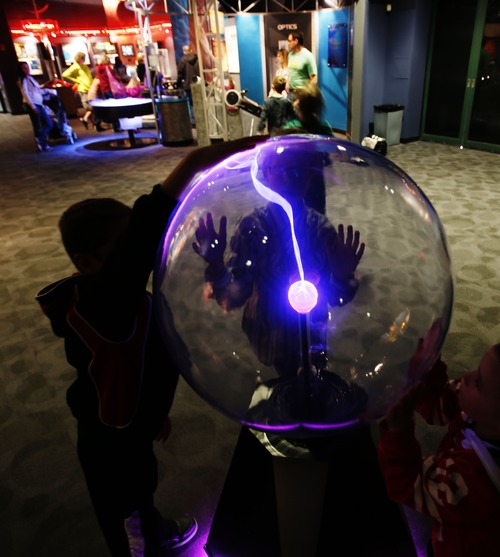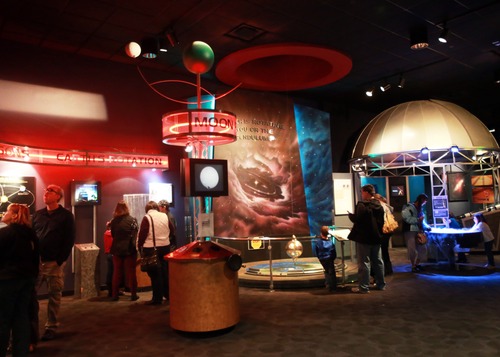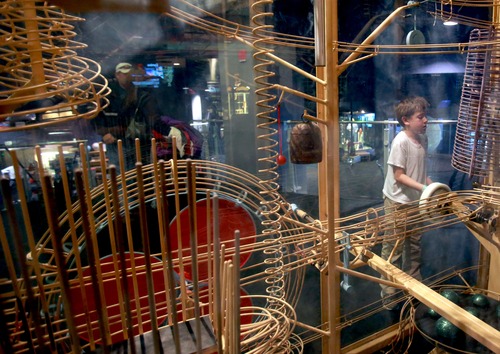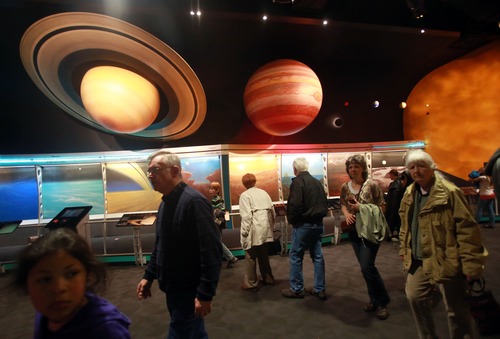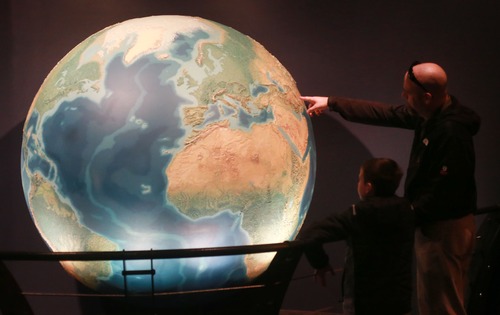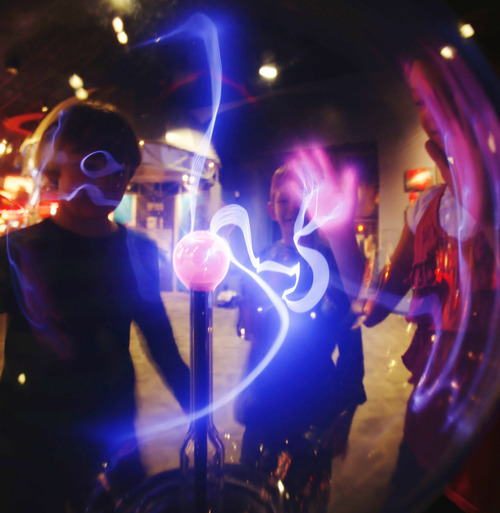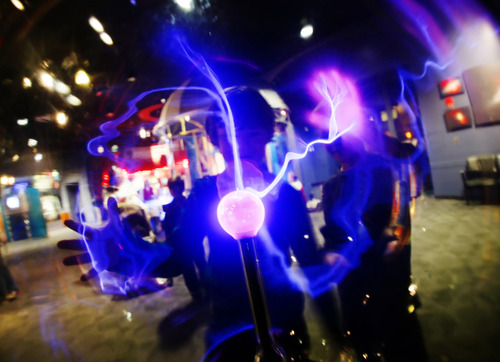This is an archived article that was published on sltrib.com in 2013, and information in the article may be outdated. It is provided only for personal research purposes and may not be reprinted.
Visitors ring a large sphere suspended from the ceiling, learning how the Earth's climate changes are shifting ocean currents. Kids walk on models of the lunar and Martian surfaces as the odd chimes of the moving sculpture Newton's Daydream punctuate their excited murmurs. Patrons of all ages line up for snacks before the latest educational IMAX film.
The whole Clark Planetarium, now turning 10 years old, simply hums.
"In the old building, there were schoolkids during the day, but after they left, there was a lack of energy," said Carol Decaria, the planetarium's associate director of finance. "The energy here, holy moly! We had lines around the block when we opened, and that energy has never stopped."
Since Clark Planetarium opened its doors, it has become a magnet for gaggles of schoolchildren on field trips, families who browse free exhibits on the science of clouds or meteors, and teens shuffling in for the latest laser show in its dome.
It has become a place where thousands walk in and become captivated by the wonders of the universe.
—
'More than entertainment' • Clark Planetarium almost didn't exist.
After 37 years in the old Salt Lake City library building, the aging Hansen Planetarium needed $100,000 a year just to keep its limestone stabilized and heating system operational. It was drawing 195,000 people a year, raising $364,000 in dome and laser-show ticket sales and $147,000 from its store.
But Salt Lake County was picking up 55 percent of its operating costs.
Fiscal conservatives denounced investing taxpayer dollars in a new planetarium at The Gateway mall, seeing it as an entertainment venue that would create a black hole for county dollars. But after weeks of acrimonious debate in 2001, the County Council approved an $18 million bond to build it.
County Councilman David Wilde, who represents the council on the planetarium's volunteer board, initially questioned the public funding.
"I came to the conclusion that this is more than entertainment; it's education," Wilde said. "I thought, 'Hopefully it's something that will motivate young people to get involved in disciplines that are so important these days,' and I decided to vote to support it."
It's a decision he's never regretted.
Within its first two months in 2003, Clark Planetarium welcomed 100,000 visitors and raised a half-million dollars.
During boom years, the planetarium added new exhibits and renovated its IMAX theater to partner with the Megaplex Theatres to show Hollywood films at night.
On average, the county pays 29 percent of its operating expenses, allocating $14.5 million over 10 years. While the planetarium isn't aiming for financial independence, it wants to limit its need for county support and fund most of its operating costs through sales and donations.
County funding, visitors and sales all dipped during the economic downturn, and, since the opening of the nearby City Creek Center, fewer potential guests are walking by. But last year, the planetarium collected $800,000 in revenue at its store and sold $865,000 in tickets to the dome and IMAX shows.
"We out-Ferengi the Ferengi in being entrepreneurial," said Director Seth Jarvis, referring to an enterprising alien race featured on "Star Trek." "All things considered, we're doing pretty well."
—
Engaging in science • More than 450,000 students have attended shows in the planetarium's dome, watching spiral galaxies collide or traveling with aliens looking for a life-supporting planet. Of the 31 shows so far, 19 were produced by staff. The planetarium's AstroVan outreach program has visited all of Utah's 41 school districts to reach an additional 315,000 kids.
Former U.S. Sen. Jake Garn, who flew aboard the space shuttle Discovery as a payload specialist during a NASA mission in 1985, serves on the volunteer board. He sees the planetarium's contribution to science and engineering education as critical.
"My father was a pilot in World War I who got his wings 14 years after the Wright brothers first flew, and his little boy got to fly in space," Garn said. "The technological changes are so amazing and so rapid. It's why education becomes so important. We need to train our brains to take advantage of all the opportunities that haven't even been invented yet."
Heather Noland, who teaches first grade for Challenger School in Salt Lake City, has taken her sons to every planetarium exhibit and film for the past five years.
"Astronomy is so mind-blowing," she said. "Their presentations and movies are always changing, so we always have the means to learn something else."
Sean Noland, 11, likes "the part...where you make man-made clouds" and the film "Violent Universe," which taught him "comets can be very, very dangerous if they enter the Earth's atmosphere."
His younger brother Tadg, 8, enjoys the films, especially "Space Junk," and the standing exhibits, particularly "the one where there is this ball with lightning that comes out," he said, referring to a Tesla ball.
In a recent planetarium class offered with Art Access, the boys made models of planetary nebulae by pressing painted string onto paper. Tadg Noland appreciated the deep-space photos that Jarvis showed them.
"I learned that the stars in the center of the nebula blow out the gas from the center of the nebulae," he said.
Grant Clayton, an adjunct mechanical-engineering professor at the University of Utah, spent many childhood afternoons and weekends exploring Seattle's Pacific Science Center. He eventually raised his family in Utah, taking his children to Hansen Planetarium. His daughter, Merinda, was a young volunteer there and started working as an usher at age 16. In 2005, she married her husband, Tom, beneath the digital stars of the Clark Planetarium dome in what appears to have been its first wedding.
"I've always thought it incumbent on me and all of us to do what we can to encourage young people to look into science and engineering fields," said Grant Clayton, who earned engineering and law degrees. "Clark Planetarium is one of those ways to do that."
—
Asking the big questions • As the county and the planetarium's board of directors plan the next 10 years, Jarvis said, "we need to ask ourselves who are we and why do we care about this place."
While he believes "we accomplish too much good to say we're an unnecessary frill," he wants to return the focus to education.
The IMAX screen was lucrative when it was the only one along the Wasatch Front, but now Jarvis questions the 2010 partnership with Megaplex Theatres to boost bucks as four other screens opened in Salt Lake and Davis counties. Now the large-screen format is more associated with hobbits and superheroes than with the 42 science and nature films selected by planetarium staff, he said.
"Some of the things we've hitched our wagon to have diluted our branding in the public brain space."
He hopes the planetarium continues to inspire people to ponder the questions visitors so often ask him: Why are we here? What does it all mean?
"It's important not to focus on the verbs of those questions, but rather the subjects," he said. "You can't call that a useful question until you understand what 'here' and 'it all' means."
The aim, he said, is to help people "have more encompassing, inclusive understanding of what 'here' is."
Twitter: @sheena5427 —
10 days of activities for 10th anniversary
Thursday, April 4
Youth art show opening reception
Friday, April 5
Community partner day
Free hands-on activities for kids
Saturday, April 6
10 years of space exploration
Live, narrated show in the dome theater followed by a reception
Sunday, April 7
Discounted dome shows
Prices will revert back to 2003 prices
Monday, April 8
Education day
Main exhibit space will feature science experiments.
Tuesday, April 9
Food truck day
Staff will offer science and solar-telescope demonstrations and people can buy lunch.
Wednesday, April 10
Employee appreciation day
Employee luncheon
Thursday, April 11
10 year anniversary gala
Phil Plait, former NASA scientist and author of the Bad Astronomy blog will speak. Tickets for the lecture are $35, but for the full gala, including dinner and cocktails, tickets are $125.
Friday, April 12
West Jordan Library lecture
Presenters will give the 10 years of astronomy lecture at Viridian Library.
Saturday, April 13
Sun/Star party in Sandy
Solar and regular telescopes will be set up at Dimple Dell Recreation Center. —
Planetarium hot potato
Hansen Planetarium was opened in 1965 by Salt Lake City's library board. In 1977, Salt Lake County took over operations, followed by the University of Utah in 1996.
The county worked to get it back in 2000. In 2001, the county approved the $18 million bond to build the Clark Planetarium which opened in April 2003 at The Gateway, 110 S. 400 West, in Salt Lake City.
The county now pays $1.4 million a year on the bond, which it expects to pay off in 2017.
Clark sees four times as many visitors as Hansen, in a building that is three times larger but has the same number of staff members.
Source: Clark Planetarium



